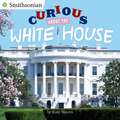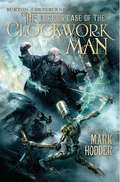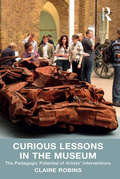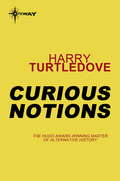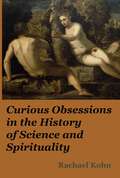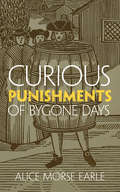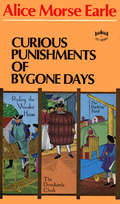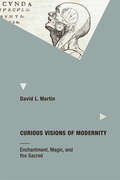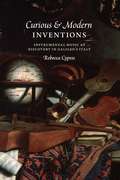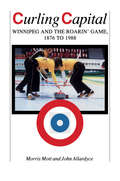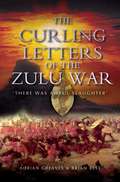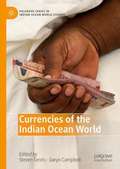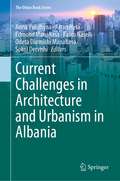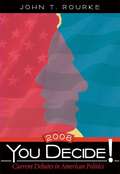- Table View
- List View
Curious About the White House (Smithsonian)
by Kate WatersCome on into America's most famous home! Everybody knows the building at 1600 Pennsylvania Avenue. It's the White House, home to US presidents, first ladies, first children, and even first pets! But aren't you curious: why is the house white (and how many gallons of paint keep it that way)? Who built the place? How many rooms are in there and what are they used for? Where does the president work? Where does the first family live? Is there really a bowling alley in the White House? The lively text and interesting photographs in this fact-filled 8 x 8 will answer all these questions and more about daily life in the most famous house in America.
Curious Case of the Clockwork Man (A Burton & Swinburne Adventure #2)
by Mark HodderMark Hodder's second Burton & Swinburne steampunk adventure, following the acclaimed The Strange Affair of Spring Heeled Jack, is filled with eccentric steam-driven technology, grotesque characters, and a deepening mystery. When a clockwork-powered man of brass is found abandoned in Trafalgar Square, Burton and his assistant, the wayward poet Algernon Swinburne, find themselves on the trail of the stolen Garnier Collection--black diamonds rumored to be fragments of the Lemurian Eye of Naga, a meteorite that fell to Earth in prehistoric times. From a haunted mansion to the Bedlam madhouse, from South America to Australia, from séances to a secret labyrinth, Burton struggles with shadowy opponents and his own inner demons. Can the king's agent expose a plot that threatens to rip the British Empire apart, leading to an international conflict the like of which the world has never seen? And what part does the clockwork man have to play?
Curious Customs: The Stories Behind 296 Popular American Rituals
by Tad TulejaWhy do we blow out candles on birthday cakes? Use striped poles to symbolize a barber? Throw rice at weddings? Find out in CURIOUS CUSTOMS: The Stories Behind 296 Popular American Rituals. Whether you want a new look at old habits or just love wacky facts and intriguing information, CURIOUS CUSTOMS is full of unusual, surprising bits of information that you'll love to learn and share.
Curious Encounters: Voyaging, Collecting, and Making Knowledge in the Long Eighteenth Century (UCLA Clark Memorial Library Series)
by Mary Terrall Adriana CraciunWith contributions from historians, literary critics, and geographers, Curious Encounters uncovers a rich history of global voyaging, collecting, and scientific exploration in the long eighteenth century. <P><P>Leaving behind grand narratives of discovery, these essays collectively restore a degree of symmetry and contingency to our understanding of encounters between European and Indigenous people. To do this the essays consider diverse agents of historical change, both human and inanimate: commodities, curiosities, texts, animals, and specimens moved through their own global circuits of knowledge and power. <P><P>The voyages and collections rediscovered here do not move from a European center to a distant periphery, nor do they position European authorities as the central agents of this early era of globalization. Long distance voyagers from Greenland to the Ottoman Empire crossed paths with French, British, Polynesian, and Spanish travelers across the world, trading objects and knowledge for diverse ends. <P><P>The dynamic contact zones of these curious encounters include the ice floes of the Arctic, the sociable spaces of the tea table, the hybrid material texts and objects in imperial archives, and the collections belonging to key figures of the Enlightenment, including Sir Hans Sloane and James Petiver.
Curious Events in History
by Michael PowellForty strange-but-true historical happenings—from a thirty-eight-minute war to the time when a top-hat caused a riot—from the author of Lies You Learned in School.Here are forty of the most curious events in world history. Though they span the centuries and circle the globe, they share one common trait: all were too peculiar to make it into the standard history books. Read these fascinating accounts and learn about:The craze for consuming powdered mummy to cure all ailmentsThe medieval courtroom advocate who pled the case of plaintiff ratsThe U.S. President who was shot by an assassin but killed by his doctor’s earnest efforts to treat himIf you thought you knew all you needed to know about history, this book will show you some truly curious gaps in your knowledge.
Curious Lessons in the Museum: The Pedagogic Potential of Artists' Interventions
by Claire RobinsAmongst recent contemporary art and museological publications, there have been relatively few which direct attention to the distinct contributions that twentieth and twenty-first century artists have made to gallery and museum interpretation practices. There are fewer still that recognise the pedagogic potential of interventionist artworks in galleries and museums. This book fills that gap and demonstrates how artists have been making curious but, none-the-less, useful contributions to museum education and curation for some time. Claire Robins investigates in depth the phenomenon of artists' interventions in museums and examines their pedagogic implications. She also brings to light and seeks to resolve many of the contradictions surrounding artists' interventions, where on the one hand contemporary artists have been accused of alienating audiences and, on the other, appear to have played a significant role in orchestrating positive developments to the way that learning is defined and configured in museums. She examines the disruptive and parodic strategies that artists have employed, and argues for that they can be understood as part of a move to re-establish the museum as a discursive forum. This valuable book will be essential reading for students and scholars of museum studies, as well as art and cultural studies.
Curious Life of Nevada's LaVere Redfield, The: The Silver Dollar King
by Jack HarpsterLaVere Redfield was a prolific hoarder. When he died in 1974, his estate was estimated at more than $70 million. Executors found 680 bags of silver coins and 407,000 Morgan and Peace silver dollars in his Reno mansion. A local Reno legend, Redfield gambled regularly in Virginia Street casinos. He survived robbery and burglaries of his home, which contained false walls to store millions of silver dollars. Hating banks and paper money, as well as big government, Redfield opted to serve a prison term for income tax evasion rather than pay his debts from his ample fortune. Join author Jack Harpster for this first book-length study of this unconventional man behind the folklore and the myth.
Curious Notions (Crosstime Traffic, Book #2)
by Harry TurtledoveFollowing on last year's Gunpowder Empire, a new novel of "Crosstime Traffic"- In the San Francisco of a parallel-world in the twenty-first century in which the Kaiser's Germany won World War I and went on to dominate the world, Paul Gomes and his father, Lawrence, are secret agents from our timeline, posing as traders from a foreign land. They run a storefront shop called Curious Notions, selling what in our world is routine consumer technology-record players, radios, cassette decks-all of which is better than anything in this world, but only by a bit. Their real job is to obtain raw materials for our timeline. Just as important, they must guard the secret of Crosstime Traffic-for of the millions of parallel timelines, this is one of the few advanced enough to use that secret against us. Now, however, the German occupation police are harassing them. The police want to know where they're getting their mysterious goods. Under pressure, Paul and Lawrence hint that their supplies come from San Francisco's Chinese ... setting in motion a chain of intrigues that will put the entire enterprise of Crosstime Traffic at deadly risk.
Curious Notions: A Novel Of Crosstime Traffic (Crosstime Traffic Ser. #2)
by Harry TurtledoveIn a parallel-world 21st-century San Francisco where the Kaiser's Germany won World War One and went on to dominate the world, Paul Gomes and his father Lawrence are secret agents for our timeline, posing as traders from a foreign land. They run a storefront shop called Curious Notions, selling what is in our world routine consumer technology - record players, radios, cassette decks - all of which is better than anything in this world, but only by a bit. Their real job is to obtain raw materials for our timeline. Just as importantly, they must guard the secret of Crosstime Traffic - for of the millions of parallel timelines, this is one of the few advanced enough to use that secret against us.Now, however, the German occupation police are harassing them. They want to know where the Gomeses are getting their mysterious goods. Under pressure, Paul and Lawrence hint that their supplies come from San Francisco's Chinese...setting in motion a chain of intrigues that will put the entire enterprise of Crosstime Traffic at deadly risk.
Curious Obsessions in the History of Science and Spirituality
by Rachael KohnThe frontiers of religion and science have always been pushed forward by curious and obsessed individuals, like: the monk who kept banned books in a secret library under the nose of the pope; the explorers who searched for the lost tribes of Israel but found a new continent instead; the eccentric doctor and a mad monk who intuited scientific truths well before future generations would prove their theories correct; the archaeologists who discovered the goddess just in time for feminism; the utopians who never quite found what they were looking for; and a current flock of priests and nuns who go wherever knowledge takes them. It is a delicious quirk of history that individuals dismissed by their contemporaries as eccentrics and troublemakers are often those with the most impact on the world. Curious Obsessions in the History of Science and Spirituality is a captivating look at the famous and the forgotten who emerged in times of extreme change and social disruption to change science and spirituality for ever. During our current Covid19 pandemic, this collection is highly relevant to a world still seeking novel answers to the human condition and also drawn to old theories long ago debunked.
Curious Punishments of Bygone Days
by Alice Morse EarleColonial American justice was harsh with transgressors: liars were bound to the whipping-post and scolding women sentenced to the ducking stool. Derived from court records, newspapers, diaries, and letters, this illustrated volume offers authentic views of many traditional forms of chastisement.These punitive measures were taken against petty thieves, unruly servants, Sabbath-breakers, revilers, gamblers, drunkards, ballad-singers, fortune-tellers, and other offenders against the rigid social code of early America. "Engines of punishment" included the stocks, the pillory, the infamous scarlet letter, and other forms of public humiliation. From book burnings to brandings, this unusual book offers arresting insights into colonial concepts of crime and punishment.
Curious Punishments of bygone Days
by Alice Morse Earle Frank HazenplugIn Curious Punishments of Bygone Days, the punishment did not always fit the crime, as this fine old illustrated history of wrath and righteousness shows. One of the earliest institutions in every New England community was a pair of stocks. The first public building was a meeting house, but often before any house of God was built, the devil got his restraining engine. And who were the heinous criminals that the righteous put in the stocks? The punishment generally, in England and America both, was for petty thieves, unruly servants, Sabbath-breakers, revilers, gamblers, drunkards, ballad-singers, fortunetellers,traveling musicians, and a variety of other offenders.
Curious Scotland: Tales from a Hidden History
by George RosieScottish history isn't just about Robert Burns and Braveheart. In fact, it's far more complex than some might think. In Curious Scotland, journalist George Rosie digs deep into Scotland's past, unearthing some of the lesser known, but more surprising details, including: Who was behind the military's "Operation Vegetarian"? What Became of the Glasgow Frankenstein? Why do Scots always spit on a certain Edinburgh street? And how did John Ross become the greatest Cherokee chieftain? Rosie answers these and other questions, illuminating corners of Scottish lore that have never been explored before. With a dry wit and unflagging curiosity, he shows us that Scotland's history is full of far stranger stuff than your average plate of haggis. Learn about the Scottish connection with the Cherokee Nation where all of the land was sacred and selling it without permission was punishable by death. Discover that Daniel De Foe, author of Robinson crusoe, lived in Scotland as a British spy. Meet the highly educated Doctor Archie Cameron, who had treated both Scottish and British soldiers at the battle at Culloden and was executed unnecessarily years later. In chapters ranging from 3 to 20 pages long, he explains how witches were found, tried and executed and how Jonathan Swift incessantly wrote nasty remarks about Scottish people in the margins of his manuscripts. This fast paced, intriguing book will appeal to general readers and history buffs alike.
Curious Toys
by Elizabeth HandAn intrepid young woman stalks a murderer through turn-of-the-century Chicago in "this rich, spooky, and atmospheric thriller that will appeal to fans of Henry Darger and Erik Larson alike." (Sarah McCarry)In the sweltering summer of 1915, Pin, the fourteen-year-old daughter of a carnival fortune-teller, dresses as a boy and joins a teenage gang that roams the famous Riverview amusement park, looking for trouble.Unbeknownst to the well-heeled city-dwellers and visitors who come to enjoy the midway, the park is also host to a ruthless killer who uses the shadows of the dark carnival attractions to conduct his crimes. When Pin sees a man enter the Hell Gate ride with a young girl, and emerge alone, she knows that something horrific has occurred. The crime will lead her to the iconic outsider artist Henry Darger, a brilliant but seemingly mad man. Together, the two navigate the seedy underbelly of a changing city to uncover a murderer few even know to look for.
Curious Unions: Mexican American Workers and Resistance in Oxnard, California, 1898-1961 (Race and Ethnicity in the American West)
by Frank P. BarajasCésar E. Chávez came to Oxnard, California, in 1958, twenty years after he lived briefly in the city as a child with his migrant farmworker family during the Great Depression. This time Chávez returned as the organizer of the Community Service Organization to support the unionization campaign of the United Packinghouse Workers of America. Together the two groups challenged the agricultural industry’s use of braceros (imported contract laborers) who displaced resident farmworkers.The Mexican and Mexican American populations in Oxnard were involved in cultural struggles and negotiations long before Chávez led them in marches and active protests. Curious Unions explores the ways in which the Mexican community forged intriguing partnerships with other ethnic groups within Oxnard in the first half of the twentieth century and the resulting economic exchanges, cultural practices, and labor and community activism. Frank P. Barajas examines how the Oxnard ethnic Mexican population exercised its agency in alliance with other groups and organizations to meet their needs before large-scale protests and labor unions were engaged. Curious Unions charts how the cultural negotiations that took place in the Oxnard ethnic Mexican community helped shape and empower farm labor organizing.
Curious Visions of Modernity: Enchantment, Magic, and the Sacred
by David L. MartinHaunted by a secret knowledge and a repressed enchantment, Western rationality is not what it seems.Rembrandt's famous painting of an anatomy lesson, the shrunken head of an Australian indigenous leader, an aerial view of Paris from a balloon: all are windows to enchantment, curiosities that illuminate something shadowy and forgotten lurking behind the neat facade of a rational world. In Curious Visions of Modernity, David Martin unpacks a collection of artifacts from the visual and historical archives of modernity, finding in each a slippage of scientific rationality—a repressed heterogeneity within the homogenized structures of post-Enlightenment knowledge. In doing so, he exposes modernity and its visual culture as haunted by precisely those things that rationality sought to expunge from the “enlightened” world: enchantment, magic, and wonderment. Martin traces the genealogies of what he considers three of the most distinct and historically immediate fields of modern visual culture: the collection, the body, and the mapping of spaces. In a narrative resembling the many-drawered curiosity cabinets of the Renaissance rather than the locked glass cases of the modern museum, he shows us a world renewed through the act of collecting the wondrous and aberrant objects of Creation; tortured and broken flesh rising from the dissecting tables of anatomy theaters to stalk the discourses of medical knowledge; and the spilling forth of a pictorializing geometry from the gilt frames of Renaissance panel paintings to venerate a panoptic god. Accounting for the visual disenchantment of modernity, Martin offers a curious vision of its reenchantment.
Curious and Modern Inventions: Instrumental Music as Discovery in Galileo's Italy
by Rebecca CypessEarly seventeenth-century Italy saw a revolution in instrumental music. Large, varied, and experimental, the new instrumental repertoire was crucial for the Western tradition--but until now, the impulses that gave rise to it had yet to be fully explored. Curious and Modern Inventions offers fresh insight into the motivating forces behind this music, tracing it to a new conception of instruments of all sorts--whether musical, artistic, or scientific--as vehicles of discovery. Rebecca Cypess shows that early modern thinkers were fascinated with instrumental technologies. The telescope, the clock, the pen, the lute--these were vital instruments for leading thinkers of the age, from Galileo Galilei to Giambattista Marino. No longer used merely to remake an object or repeat a process already known, instruments were increasingly seen as tools for open-ended inquiry that would lead to new knowledge. Engaging with themes from the history of science, literature, and the visual arts, this study reveals the intimate connections between instrumental music and the scientific and artisanal tools that served to mediate between individuals and the world around them.
Curled Up with an Earl (The Byronic Book Club #2)
by Amy Rose Bennett"Ever since we first met, I've imagined what it would be like to be in your arms, to feel your lips upon mine. I'm twenty-eight years old. A shy and oft-times awkward spinster with singular scientific interests, and I've…I've never been kissed. Not once. In fact, I never thought I would ever want to be kissed. But then I met you and…and I do want this. Very much."Miss Lucy Bertram is content to spend her days writing scientific articles or curling up with a Gothic romance novel. Indeed, she'd rather stick a hatpin in her eye than attend a ball. But when her father, the eccentric botanist Sir Oswald, insists she accept the suit of a wealthy but stiffer-than-a-poker industrialist to save the family from penury, Lucy decides to act. She's certain her disowned brother, Monty, will take her side. But first she must find him in St. Giles's cutthroat rookeries. A covert agent for the Crown, William Lockhart, the Earl of Kyle, is on the hunt for a ruthless killer determined to destroy the Linnean Society. Sir Oswald, a botanical poisons expert, is the prime suspect. Posing as a groom in the baronet's household, it shouldn't take Will long to unearth the evidence Scotland Yard needs. If only the beguiling Miss Bertram wasn't so damn distracting…As an unexpected but undeniable passion flares between Lucy and Will, confidences are exchanged and dark secrets come to light. But will a murderer, determined to stay hidden, destroy their chances of finding a happy-ever-after?
Curling Capital
by Morris Mott John AllardyceThe major themes in this volume are the rise of Winnipeg to world curling prominence in the nineteenth century and the persistence of that prominence in the twentieth.
Curling Letters of the Zulu War: There Was Awful Slaughter (19th Century Ser.)
by Brian Best"The crushing defeat suffered by the British Army by the Zulus at Isandlwana on 22 January 1879 is by any standards a gripping and shocking story. The discovery of a complete set of diaries written by a young Royal Artillery officer who was the only survivor of his unit which lost all their guns is a very important find. Not only does this superb record tell of the dramatic events of that fateful day but it captures the atmosphere of the whole campaign and the age in which it was fought, and makes for compulsive reading. "
Currahee!: A Screaming Eagle at Normandy
by Donald R. Burgett<p>No other book on D-Day can approach <i>Currahee!</i> Among all the accounts by officers and war correspondents it stands alone: the only account of D-Day by a private soldier who lived through the fighting. <p>Told simply but with total recall, this is the combat narrative of a 19-year-old paratrooper who took part in the momentous invasion of Normandy as a PFC in the 506th Parachute Regiment and fought almost continuously for five days and nights in the battle to secure the beachhead. <p>In <i>Currahee!</i> Burgett tells of killing and heroism, the confusion of war and the shock of death, as he presents his stunning eyewitness account of D-Day--living through an experience he could never forget.</p>
Currencies of Imagination: Channeling Money and Chasing Mobility in Vietnam
by Ivan V. SmallIn Vietnam, international remittances from the Vietnamese diaspora are quantitatively significant and contribute important economic inputs. Yet beyond capital transfer, these diasporic remittance economies offer insight into an unfolding transformation of Vietnamese society through the extension of imaginations and ontological possibilities that accompany them. Currencies of Imagination examines the complex role of remittances as money and as gifts that flow across, and mediate between, transnational kinship networks dispersed by exile and migration.Long distance international gift exchanges and channels in a neoliberal political economy juxtapose the increasing cross-border mobility of remittance financial flows against the relative confines of state bounded bodies. In this contradiction Ivan V. Small reveals a creative space for emergent imaginaries that disrupt local structures and scales of desire, labor and expectation. Furthermore, the particular characteristics of remittance channels and mediums in a global economy, including transnational mobility and exchangeable value, affect and reflect the relations, aspirations, and orientations of the exchange participants. Small traces a genealogy of how this phenomenon has shifted through changing remittance forms and transfer infrastructures, from material and black market to formal bank and money services. Transformations in the affective and institutional relations among givers, receivers, and remittance facilitators accompany each of these shifts, illustrating that the socio-cultural work of remittances extends far beyond the formal economic realm they are usually consigned to.
Currencies of the Indian Ocean World (Palgrave Series in Indian Ocean World Studies)
by Steven Serels Gwyn CampbellThis book is the first to trace the unique monetary history of the Indian Ocean World. Long-distance trade across the region was facilitated by a highly complex multi-currency system undergirded by shared ideas that transcended ethno-linguistic, religious and class divisions. Currencies also occupied key roles in local spiritual, aesthetic and affective practices. Foregrounding these tensions between the global/universalistic and the local/particularistic, the volume shows how this traditional currency system remained in place until the middle of the twentieth century, and how aspects of the system continue to inform monetary practices throughout the region. With case studies covering China, India, the Arabian Sea, the Red Sea, East Africa, Zanzibar, Madagascar and Mauritius from the thirteenth to the twenty-first centuries, this volume explores the central role currencies played in economic exchange as well as in establishing communal bonds, defining state power and expressing religious sentiments.
Current Challenges in Architecture and Urbanism in Albania (The Urban Book Series)
by Anna Yunitsyna Artan Hysa Edmond Manahasa Fabio Naselli Odeta Durmishi Manahasa Sokol DervishiThis book aims to provide a cross-sectorial assessment in a multidisciplinary and trans-cultural context onto the innovations in urban and architectural approaches in designing next human environments within the Albanian context. The continuous concentration of the world population in the urban areas and their consequent densification require even more quantity of quality spaces and places, integrated resources and energies, alternative modalities of mobility and transports, demand of social inclusion and need for a circular economy. These have become the major challenges for this 21st Century and some of the greatest problems facing humanity in most of current vision for the future. The main objective is to feed a debate about the emerging trans-cultural (and trans-national) approaches in the whole designing field, from Albanian context and its current good practices, attempts and faults, both formal and informal. Thus, the Albanian experience may represent an opportunity through which we all may reflect about how designing is evolving in the Mediterranean arena of “praxis and experiments” aimed to a better quality of life at the human scale and in expanding the concepts of “place and space” such as it has improved by the effects in designing innovations.This book represents a useful read of theories, experiences and case studies, which can help in enlarging reflection on how the designing practice is evolving in the arena of forthcoming development strategies and tactics, all addressed to improve the quality of life, places and spaces. Additionally, it provides a range of architecture and urban design rationales and strategies for reinforcing identities and creating memorable places within the quality of contemporary architecture and urbanism. It addresses the unique needs of architects and planners to deal with topics that cut across social, economic and environmental issues and shows readers how to explore methods, theoretical frameworks and techniques to address the complex needs of architecture, urban and cultural development.
Current Debates in American Politics
by John T. RourkeUpdated annually, this best-selling, debate-style reader examines the most timely, important, and provocative issues in American politics.
